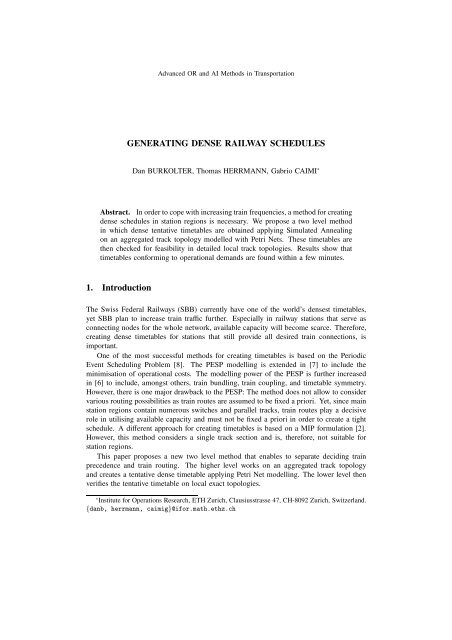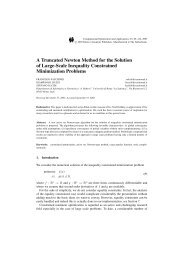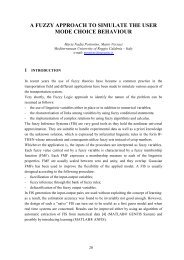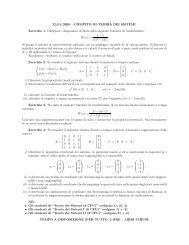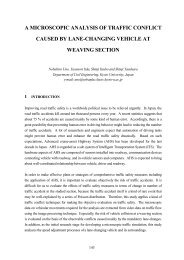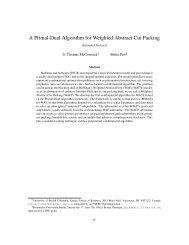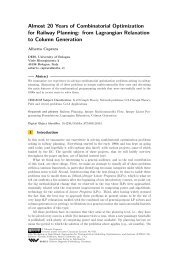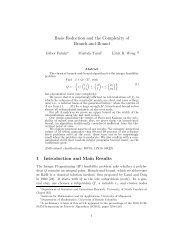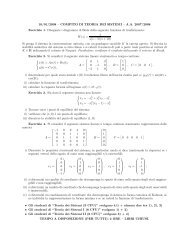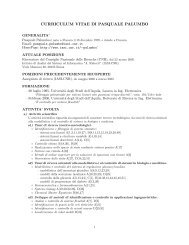GENERATING DENSE RAILWAY SCHEDULES 1. Introduction
GENERATING DENSE RAILWAY SCHEDULES 1. Introduction
GENERATING DENSE RAILWAY SCHEDULES 1. Introduction
You also want an ePaper? Increase the reach of your titles
YUMPU automatically turns print PDFs into web optimized ePapers that Google loves.
Advanced OR and AI Methods in Transportation<br />
<strong>GENERATING</strong> <strong>DENSE</strong> <strong>RAILWAY</strong> <strong>SCHEDULES</strong><br />
Dan BURKOLTER, Thomas HERRMANN, Gabrio CAIMI ∗<br />
Abstract. In order to cope with increasing train frequencies, a method for creating<br />
dense schedules in station regions is necessary. We propose a two level method<br />
in which dense tentative timetables are obtained applying Simulated Annealing<br />
on an aggregated track topology modelled with Petri Nets. These timetables are<br />
then checked for feasibility in detailed local track topologies. Results show that<br />
timetables conforming to operational demands are found within a few minutes.<br />
<strong>1.</strong> <strong>Introduction</strong><br />
The Swiss Federal Railways (SBB) currently have one of the world’s densest timetables,<br />
yet SBB plan to increase train traffic further. Especially in railway stations that serve as<br />
connecting nodes for the whole network, available capacity will become scarce. Therefore,<br />
creating dense timetables for stations that still provide all desired train connections, is<br />
important.<br />
One of the most successful methods for creating timetables is based on the Periodic<br />
Event Scheduling Problem [8]. The PESP modelling is extended in [7] to include the<br />
minimisation of operational costs. The modelling power of the PESP is further increased<br />
in [6] to include, amongst others, train bundling, train coupling, and timetable symmetry.<br />
However, there is one major drawback to the PESP: The method does not allow to consider<br />
various routing possibilities as train routes are assumed to be fixed a priori. Yet, since main<br />
station regions contain numerous switches and parallel tracks, train routes play a decisive<br />
role in utilising available capacity and must not be fixed a priori in order to create a tight<br />
schedule. A different approach for creating timetables is based on a MIP formulation [2].<br />
However, this method considers a single track section and is, therefore, not suitable for<br />
station regions.<br />
This paper proposes a new two level method that enables to separate deciding train<br />
precedence and train routing. The higher level works on an aggregated track topology<br />
and creates a tentative dense timetable applying Petri Net modelling. The lower level then<br />
verifies the tentative timetable on local exact topologies.<br />
∗ Institute for Operations Research, ETH Zurich, Clausiusstrasse 47, CH-8092 Zurich, Switzerland.<br />
{danb,herrmann,caimig}@ifor.math.ethz.ch
Generating dense railway schedules 291<br />
The paper is structured as follows. Section 2 describes the two modelling levels. Section<br />
3 addresses the problem of avoiding deadlocks in the modelling. Section 4 describes the<br />
optimisation problem and the applied heuristic. Section 5 shows the obtained results.<br />
Finally, Section 6 gives our conclusions.<br />
2. Two Level Model<br />
The typical layout of a main station region consists of stretches of several parallel tracks<br />
leading to different major directions. These stretches are connected by switch regions to<br />
make all tracks accessible. The important fact is that the switch regions are short relative<br />
to the stretches and are, therefore, passed quickly by trains. Choosing routing and train<br />
precedence is separated by creating an aggregated global topology in which each switch<br />
region is reduced to a node providing connections among all incoming tracks. A train<br />
run now consists of a series of stretches with interconnecting nodes. Thus, the route is<br />
fixed except for deciding which of a number of parallel tracks to use, see Figure 1 for an<br />
example. Now, train precedence can be determined for each stretch individually subject<br />
to the available capacity that is given by the number of parallel tracks present. Choosing<br />
train precedence in this topology will generate a tentative timetable which guarantees that<br />
capacity restrictions on the stretches are met.<br />
Portal Node<br />
Portal Node<br />
Switch Node<br />
Main Station<br />
Switch Node<br />
Portal Node<br />
Figure <strong>1.</strong> Example of an aggregated station topology.<br />
Petri Nets provide an ideal means for modelling and analysing timetables [5]. These<br />
tools not only make it possible to easily calculate the cycle time of a timetable but also to<br />
find the specific sequence of events within the timetable that prevents a further tightening<br />
of the schedule without changing some train precedence. As a modelling tool, Petri Nets<br />
allow incorporating train precedence and interconnections as well as capacity restrictions on<br />
stretches with parallel tracks and, therefore, fit the modelling requirements on the aggregated<br />
level which gives reason to use them here.<br />
Independent Set Modelling of the Lower Level<br />
Now assume that a timetable has been found in this simplified aggregated topology. Is it<br />
feasible? Not necessarily, since it was assumed that the switch regions had infinite capacity.<br />
Therefore, the tentative timetable has to be checked in a fully detailed track topology of<br />
each switch region. The tentative timetable is feasible if a routing for all trains can be found
292 D. Burkolter et al.<br />
such that no track section is used by two trains at the same time (including safety distance).<br />
The feasibility check is modelled as an independent set problem in the following manner.<br />
All possible routes through the switch region are listed for each train individually. Each<br />
route corresponds to a node in a graph and two nodes are connected if the corresponding<br />
routes are in conflict, i.e. the corresponding trains would use some track segment at the<br />
same time. Additionally, all routes of the same train are connected with edges, i.e. build a<br />
clique, since only one route for each train is needed.<br />
A feasible solution to the problem is now given by a maximum independent set. A tight<br />
upper bound on the maximum cardinality is known due to the clique structure of the graph.<br />
The maximum cardinality is equal to the number of trains if and only if it is possible to<br />
find a conflict-free routing for all trains. Zwaneveld et al. have studied this problem in [9].<br />
They show that the problem is NP-complete and propose a Branch and Cut algorithm to<br />
find a solution. In order to solve the problem, we have chosen a fixed point iteration method<br />
[1] which is a specialised version of a heuristic for solving Constrained Semi-Assignment<br />
Problems [3].<br />
Petri Net Modelling of the Aggregated Level<br />
Given is a train service intention consisting of a number of train lines and desired connections<br />
among them and an aggregated topology that shall be modelled using Petri Nets. The<br />
modelling encompasses three steps:<br />
<strong>1.</strong> Each train run is depicted by an own Petri Net circuit consisting of all relevant events,<br />
e.g. arrivals and departures at parallel track stretches, and holding times in between.<br />
The circuit is closed by an arc from the transition representing the train’s departure<br />
from the station region and the entry transition with a place in between holding one<br />
token representing the train (places P1 and P2 in Figure 2).<br />
2. Additional transitions are introduced which ensure that the desired train interconnections<br />
are possible. For each connection, a transition is added that cannot fire before<br />
all feeder trains have arrived (transition T in Figure 2). Thereafter, the firing of this<br />
transition enables the departure of the trains.<br />
3. The last step is introducing the capacity restrictions. Each region of limited track<br />
resources given by the aggregated topology is represented by a new place (place P3<br />
in Figure 2). The number of tokens in this place is equal to the number of parallel<br />
tracks. Now, every train line passing through this stretch is connected to the new<br />
place in the following manner. An arc from the place holding tokens representing<br />
train tracks to the transition “arrival in beginning node of stretch” is inserted. An<br />
additional arc is used to make a connection from the transition “departure in ending<br />
node of stretch” back to the place supplying train tracks. Thus, when a train arrives<br />
in the stretch it occupies one of the available tracks by receiving one of the track<br />
tokens and this track is freed for usage again when the train leaves the stretch and<br />
returns the track token.<br />
The modelling of the capacity restrictions creates places with more than one in- and<br />
outgoing arc. Thus, the Petri Net is not decision free, i.e. the entering order of the trains<br />
into the regions with restricted capacity is not fixed. Determining the train precedence
Generating dense railway schedules 293<br />
P1<br />
P3<br />
T<br />
P2<br />
Figure 2. Petri Net of two train runs. Both trains share a single track area represented<br />
by the place P3. The train departures are synchronised by the transition T.<br />
order makes the Petri Net decision free, see Figure 3. A decision free Petri Net is called<br />
event graph and can be evaluated easily. In particular, the shortest possible cycle time<br />
of the Petri Net, i.e. the minimum time needed to return to the initial state of the net,<br />
and a corresponding timetable which achieves this minimum can be calculated efficiently<br />
applying the policy iteration algorithm [4]. The optimisation problem to solve consists<br />
of determining train precedence orders for entering the stretches in such a way that the<br />
resulting event graph has minimum cycle time.<br />
P1<br />
P3<br />
P4<br />
P2<br />
T<br />
Figure 3. Transformation of Petri Net of Figure 2 into an event graph. The first train<br />
has precedence as the token is initially in P3.<br />
3. Deadlocks in Event Graphs<br />
An event graph is deadlocked if it contains a tokenless oriented circuit. In this case, the<br />
cycle time of the event graph is∞and the corresponding timetable is infeasible since there<br />
is at least one transition that has a precondition for firing that is never met.<br />
If local train precedence orders are chosen randomly, the probability of obtaining a<br />
deadlock free event graph tends exponentially in the number of trains to zero. Therefore,
294 D. Burkolter et al.<br />
hoping to create feasible initial solutions randomly is futile. However, a simple trick exists<br />
which ensures that the resulting event graph is deadlock free.<br />
Theorem 1 Assume a Petri NetPof a train service intention without any transfer restrictions<br />
is given. If all local train precedence are set according to the same fixed global<br />
precedence order, then the resulting event graph is deadlock free.<br />
Proof. If all places containing at least one token are removed from the event graph<br />
and the remaining graph still contains an oriented circuit then the original event graph was<br />
deadlocked.<br />
Now consider the Petri NetP. Since train precedence are determined globally according<br />
to a fixed order, the trains can be represented in the graph in a way that the train ranking<br />
highest in the precedence order is also highest in the graph. This train is followed by the<br />
next train in the order and so on until the last train of the order which is placed lowest in<br />
the graph. Now, by inserting all arcs due to the limited resources in the critical regions,<br />
the following picture is obtained. All new arcs containing places without tokens point<br />
“downwards” in the graph. If all places containing a token are removed, the remaining<br />
graph cannot contain a circuit as there are no arcs pointing “upwards”, see Figure 4. ♦<br />
Figure 4. Three trains passing two single track sections. The precedence order is the<br />
same in both critical places. The right most Petri Net shows that no token free circuit<br />
was created.<br />
Usually a train service intention will include some connections among trains. However,<br />
refining the previous trick with the additional restriction that all departing trains are placed<br />
behind the last arriving train in the global precedence order will guarantee a deadlock free<br />
event graph. Thus, large numbers of feasible timetables for the aggregated topology are<br />
easily constructed: #˜Θ=|T in |!·|Tout|! where #˜Θ is the number of tentative timetables<br />
and T in and Tout are the sets of arriving and departing trains. However, the global train<br />
precedence rule is not optimal since it does not allow train overtakings.<br />
4. Problem Formulation and Heuristic<br />
The timetabling problem consists of finding local train precedence orders such that the<br />
cycle time of the timetable is minimised. More formally: Given is a set P crit of stretches<br />
p i , i = 1,...,|P crit |. Each has a set T pi of passing trains and a number of tokensµ pi<br />
equal to the number of parallel tracks. A solution to the train timetabling problem consists<br />
of a partitioning of T pi intoµ pi disjoint sets Tp j i<br />
, j = <strong>1.</strong>..µ pi . Additionally, each Tp j i
Generating dense railway schedules 295<br />
has an orderingσp j i<br />
of its elements which is the precedence on the associated track. The<br />
optimisation problem consists of finding partitions and orderings such that the resulting<br />
cycle time is minimal.<br />
The very similar job shop scheduling problem which isNP-hard, can be reduced to<br />
this timetabling problem. Therefore, it is futile to aim at solving the problem optimally.<br />
Instead, a good heuristic is needed to find a satisfactory solution within reasonable time.<br />
Initial feasible solutions can be generated using global train precedence rules. It is also<br />
conceivable that these are in fact rather good initial solutions since one does not expect<br />
many train overtakings within a station region. Yet, some overtakings should take place as<br />
for example there are minor stations within the region in which only commuter trains stop.<br />
The other trains should not be forced to wait and, thus, repartitioning and reordering the<br />
train precedence locally will yield better results. A matter of interest is therefore to detect<br />
potentially good adjustments of the local train precedence.<br />
The Petri Net modelling gives insight here. Calculating the critical cycle shows which<br />
trains prevent a shorter cycle time for the current set of precedence. Only changing precedence<br />
of trains that belong to the critical cycle might decrease the cycle time since otherwise<br />
the previous critical cycle still exists. This leads to a local search heuristic for condensing<br />
timetables using the following neighbourhood:<br />
Given is a timetableΘwith corresponding precedence orders and its critical circuit.<br />
Then, we define the critical timetable neighbourhood N C (Θ) as the set of all timetables ˆΘ<br />
that are reached fromΘ by moving one train to a new position in one of the partitionings<br />
Tp j i<br />
such that a precedence on the critical circuit ofΘis altered.<br />
Note that N C (Θ) could be empty. This is the case if all places on the critical circuit are<br />
either train travelling times or restrictions due to train connections. Therefore, an empty<br />
critical timetable neighbourhood implies that the current solution is globally optimal as the<br />
critical cycle consists of unalterable successions of transitions. A further condensation of<br />
the timetable could only be achieved by changing the train service intention or changing<br />
the track topology. However, an event graph may be globally optimal without having an<br />
empty critical timetable neighbourhood.<br />
Tests showed that a local search heuristic which only allows improvements ends in<br />
unsatisfactory local optima, see the following section. Increasing the neighbourhood size<br />
has a major drawback: If more than one change is allowed in each step, the rule that only<br />
changes on the critical cycle have to be considered does not hold anymore. Thus, the notion<br />
on potentially good changes is lost. Therefore, a heuristic that temporarily allows worse<br />
solutions is preferable to changing the neighbourhood.<br />
Simulated Annealing with a constant factor temperature reduction scheme and fixed<br />
numbers of inner and outer iterations is chosen. However, only a modest number of iterations<br />
is conducted as evaluating a solution is costly. Instead in order to broadly cover the solution<br />
space, the algorithm restarts from various random starting points since generating feasible<br />
initial solutions is computationally cheap.
296 D. Burkolter et al.<br />
5. Results<br />
The station of Bern was taken as a test case. This station lies at the junction of the main<br />
north-south and east-west lines of the Swiss railway network. Trains arrive from six major<br />
directions and stop at twelve platforms. The station region has a radius of approximately 5<br />
kilometres in which over 200 switches ensure that all platforms can be reached from every<br />
direction. However, this also leads to a large number of possible routes—up to 1000. The<br />
timetable for 2003 provided a half-hourly service of 20 trains each having a buffer time of<br />
at least one minute. A possible future timetable raises the number of trains to 26. However,<br />
calculations showed that available buffer times would be less than 10 seconds for some<br />
trains (see [1]).<br />
The aim was therefore to take this service intention of 26 trains and construct a timetable<br />
with shortest possible cycle time. The difference between the achieved cycle time and final<br />
cycle time of 30 minutes could then be used as buffer time. The following results were<br />
obtained using an AMD Opteron 248 processor:<br />
Local Search Heuristic. 200 runs from different initial solutions were conducted. However,<br />
only one final solution had a timetable period below 30 minutes, its cycle time<br />
being 28.5 minutes. Local optima were found on average in <strong>1.</strong>7 minutes.<br />
Simulated Annealing. For each initial solution 1200 iterations were conducted in an average<br />
of 3.3 minutes. 64 of overall 200 runs provided a timetable with cycle time<br />
below 30 minutes. Of these 64 timetables 33 were feasible in the switch regions.<br />
The average cycle time of the feasible timetables was 28.2 minutes while the best<br />
solution had a cycle time of 25.7 minutes.<br />
6. Conclusions<br />
The chosen two level approach worked very well as half of the timetables generated in the<br />
aggregated level turned out to be feasible in the lower level and cycle times satisfied the<br />
desired timetable period. Our method inherently provides the most critical sequence within<br />
the timetable which is of high interest for train dispatchers. Moreover, the critical circuit<br />
gives hints for insertion of the generated spare time. However, there are various additional<br />
facets to take into account and the stabilisation of timetables is a subject for further research.<br />
Acknowledgements. We would like to thank the Swiss Federal Railways for funding and<br />
providing data and in particular Thomas Graffagnino and Dr. Felix Laube for insightful<br />
discussions.
Generating dense railway schedules 297<br />
References<br />
[1] G. Caimi, D. Burkolter, and T. Herrmann. Finding delay-tolerant train routings through<br />
stations. In Operations Research Proceedings 2004. Springer, 2005.<br />
[2] A. Caprara, M. Fischetti, P. L. Guida, M. Monaci, G. Sacco, and P. Toth. Solution of<br />
real-world train timetabling problems. In HICSS, 200<strong>1.</strong><br />
[3] M. Cochand. A fixed point operator for the generalised maximum satisfiability problem.<br />
Discrete Applied Mathematics, 46:117–132, 1993.<br />
[4] J. Cochet-Terrasson, G. Cohen, S. Gaubert, M. McGettrick, and J.-P. Quadrat. Numerical<br />
computation of spectral elements in max-plus algebra. In IFAC Conference on<br />
System Structure and Control, Nantes, France, 1998.<br />
[5] R. Goverde and G. Soto y Koelemeijer. Performance Evaluation of Periodic Railway<br />
Timetables: Theory and Algorithms. Number S2000/2 in Trail Studies in Transportation<br />
Science Series. The Netherlands TRAIL Research School, Delft, 2000.<br />
[6] C. Liebchen and R. H. Möhring. The modeling power of the periodic event scheduling<br />
problem: Railway timetables—and beyond. Technical report, TU Berlin, 2004.<br />
[7] T. Lindner and U. Zimmermann. Train schedule optimization in public rail transport.<br />
In Mathematics—Key Technology for the Future: Joint Projects Between Universities<br />
and Industry, pages 703–716. Springer, 2003.<br />
[8] P. Serafini and W. Ukovich. A mathematical model for periodic scheduling problems.<br />
SIAM Journal on Discrete Mathematics, 2(4), 1989.<br />
[9] P. J. Zwaneveld, L. G. Kroon, H. E. Romeijn, and M. Salomon. Routing trains through<br />
railway stations: Model formulation and algorithms. Transportation Science, 30(3):181–<br />
194, 1996.


